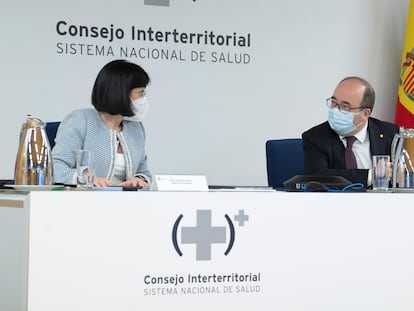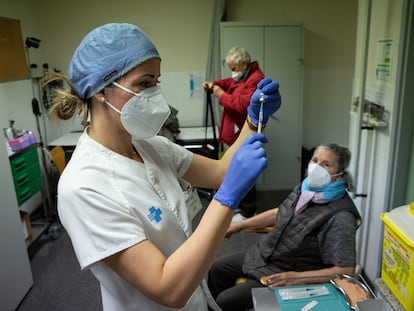Health Ministry corrects spike in coronavirus incidence, but epidemiological curve has plateaued
Meanwhile, Spain is delaying the decision to administer the AstraZeneca vaccine to the over-55s until more research has been done into possible side effects of the medication

The Health Ministry has corrected the coronavirus data that it released on Wednesday, which pointed to the first uptick in infections that had been seen since January. Thanks to Thursday’s report, it is clear that the epidemiological curve has in fact flattened, and the 14-day cumulative number of coronavirus cases per 100,000 inhabitants is now at 132.25 – just 1% down on the figure a day before.
The correction by the ministry was attributed to an “error in the data,” bringing the incidence reported on Wednesday down from 139.57 to the correct figure of 133.83. The data point had come in at 139.08 the day before.
However, there is still a threat that the curve could rise. The descent in the figures at the end of this, the third wave of the coronavirus in Spain, is getting slower each day, and is pointing to a plateau. On Tuesday, the incidence fell 2% compared to Monday; on Wednesday nearly 4% compared to the previous day; and this Thursday, the reduction was barely 1%.
The incidence indicators show that we are going in the right direction, but we still have a long way to go before we reach the objective of 25 cases per 100,000 inhabitantsHealth Minister Carolina Darias
“The incidence indicators show that we are going in the right direction, but we still have a long way to go before we reach the objective of 25 cases per 100,000 inhabitants,” said Health Minister Carolina Darias on Thursday, when she appeared in the Congress of Deputies. “We have the San José [Father’s Day] and Easter holidays ahead of us, which concern us. That is why we reached a major agreement [on Wednesday] to reduce mobility during these festivities.”
Darias went on to insist that the restrictions that have been agreed by the country’s regions and her ministry – which include perimetral lockdowns of regions, an 11pm curfew and a limit of four people who can meet in enclosed spaces – are “mandatory” for all territories. She was alluding to the Madrid regional government’s opposition to the measures approved by the Inter-Territorial Council of the National Health System (CISNS) and its insistence that it will not observe them.
According to the risk levels agreed between the Health Ministry and the regions to evaluate the alert level of each territory during the pandemic, the current incidence and positivity rate (i.e. the percentage of coronavirus tests coming back positive) put Spain at medium risk. That said, the situation varies greatly from region to region. Madrid, for example, currently has a 14-day cumulative number of coronavirus cases per 100,000 inhabitants of 225, while the North African cities of Ceuta and Melilla are at 292 and 409, respectively.
What’s more, the pressure on the country’s hospitals remains high. Intensive care units (ICUs) are taking a long time to empty out, and there are still 2,320 people across the country in a critical condition with Covid-19. This means that nearly 23% of ICU beds are still occupied by coronavirus patients, a situation that places Spain at high risk, according to the ministry’s alert system. Castilla y León, Asturias, Catalonia, Ceuta, Madrid and La Rioja are actually at extreme risk, with more than 30% of ICU beds occupied by Covid-19 patients.
Spain has now passed 72,000 official Covid-19 victims since the pandemic began, although the true figure is much higher given the number of people who died during the first wave before they could be tested. Over the last seven days, a total of 495 people have died after testing positive for Covid-19, according to Thursday’s report.
AstraZeneca
Meanwhile, the CISNS’s public health commission has decided to delay the decision to allow the Oxford-AstraZeneca Covid-19 vaccine to be used on people aged between 55 and 65, until the European Medicines Agency (EMA) evaluates and issues an expert opinion on possible side effects of the medication. The announcement came on Thursday, the same day that a number of European countries announced that they were suspending the use of the vaccine due to these possible side effects.
For now, the EMA has recommended the continued use of the AstraZeneca vaccine while research continues into possible thrombosis cases after it was administered. In a press release issued on Thursday afternoon, the EMA stated that there had been 30 such events among five million people who had received the vaccine, a figure that is no greater than the usual incidence for thrombosis cases among the general population.
At the start of February, Spain opted not to use the AstraZeneca vaccine on the over-55s given a lack of clinical trials in that age group. But evidence is continuing to emerge showing that the vaccine is as effective or even more so in older people than the Pfizer-BioNTech and Moderna vaccines – both of which have been approved for use in all age groups in Spain. Italy, Greece, Germany, Belgium, Netherlands, Sweden, France and Portugal have all already eliminated the age limit for the AstraZeneca vaccine, while it is also being used among all age groups in the United Kingdom.
English version by Simon Hunter.
Tu suscripción se está usando en otro dispositivo
¿Quieres añadir otro usuario a tu suscripción?
Si continúas leyendo en este dispositivo, no se podrá leer en el otro.
FlechaTu suscripción se está usando en otro dispositivo y solo puedes acceder a EL PAÍS desde un dispositivo a la vez.
Si quieres compartir tu cuenta, cambia tu suscripción a la modalidad Premium, así podrás añadir otro usuario. Cada uno accederá con su propia cuenta de email, lo que os permitirá personalizar vuestra experiencia en EL PAÍS.
¿Tienes una suscripción de empresa? Accede aquí para contratar más cuentas.
En el caso de no saber quién está usando tu cuenta, te recomendamos cambiar tu contraseña aquí.
Si decides continuar compartiendo tu cuenta, este mensaje se mostrará en tu dispositivo y en el de la otra persona que está usando tu cuenta de forma indefinida, afectando a tu experiencia de lectura. Puedes consultar aquí los términos y condiciones de la suscripción digital.
More information
Últimas noticias
Most viewed
- Oona Chaplin: ‘I told James Cameron that I was living in a treehouse and starting a permaculture project with a friend’
- Reinhard Genzel, Nobel laureate in physics: ‘One-minute videos will never give you the truth’
- Sinaloa Cartel war is taking its toll on Los Chapitos
- Why the price of coffee has skyrocketed: from Brazilian plantations to specialty coffee houses
- Chevy Chase, the beloved comedian who was a monster off camera: ‘Not everyone hated him, just the people who’ve worked with him’










































